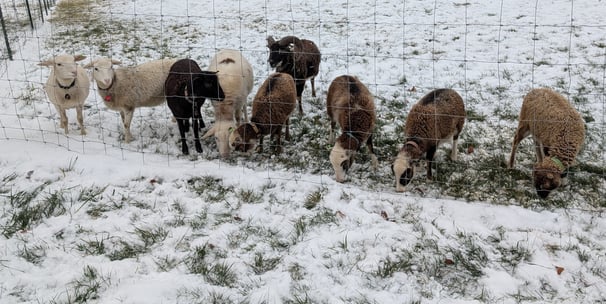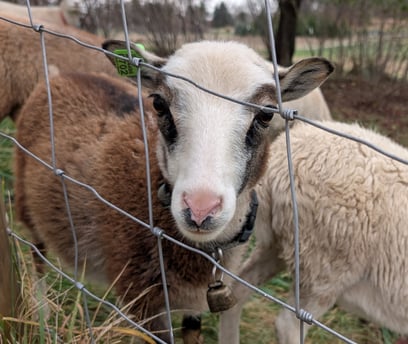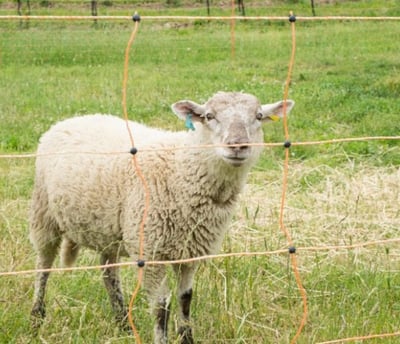Fencing: Your Most Important Investment
Invest in strong fences to keep sheep contained and protect them from predators effectively.
Sheep, especially when new to an area, will test every boundary. Underestimate their ability to escape at your peril! Good fencing isn't just about keeping them in, it's about keeping predators out and managing your pastures effectively. Sheep look for gaps (even small ones), push through weak spots, go under or over, and are especially motivated by tasty grass on the other side.
Here’s a look at the two most common and effective fencing options for sheep:


Woven Wire Fencing (Field Fence)
Often considered the gold standard, especially for perimeter boundaries, woven wire provides a strong physical barrier.
What it is: A mesh-like fence made of woven wire strands.
Why it works: It acts as a robust physical deterrent, is long-lasting when installed correctly, and offers excellent security against most predators and escapes.
Key Specifications for Sheep:
Mesh Size: Crucially, look for "sheep and goat" woven wire. This typically features 4"x4" openings (or smaller near the bottom). Larger openings (like standard field fence) are dangerous – sheep, especially lambs, can stick their heads through and get stuck or strangle themselves.
Height: Aim for a minimum height of 48 inches. Taller can be better, especially in areas with high predator pressure or for more athletic sheep breeds.
Installation: It must be stretched very tight. This requires sturdy, well-set wooden corner posts, gate posts, and brace posts. T-posts can often be used for line posts between the wooden ones.
Considerations: Woven wire has a higher initial cost for materials and installation can be labor-intensive. It's not easily moved, making it best suited for permanent boundaries. Adding a single strand of electric wire (offset) near the top and/or bottom can greatly enhance its effectiveness and prevent sheep from rubbing/pushing on it.
Electric Fencing
A versatile and cost-effective option, electric fencing relies on a psychological barrier – a memorable shock. It must be properly constructed and powered to be effective for sheep.
What it is: Uses insulated wires carrying a high-voltage, low-amperage pulse delivered by a fence charger (energizer).
Why it works: Once trained, sheep learn to respect the shock and stay away. It's excellent for interior divisions, rotational grazing, and can be more affordable for large areas.
Types & Specifications:
High-Tensile Electric: Uses 4 to 6 (or more) smooth high-tensile wires.
Spacing: Wires must be spaced correctly – closer together near the bottom (e.g., starting at 5-6 inches, then 6", 7", 8", 10") to prevent sheep from pushing through or going under.
Visibility: Using polywire or tape for at least one or two strands helps sheep see it better.
Electric Netting: Pre-made rolls of fence with wires integrated into plastic mesh and built-in posts.
Use: Ideal for temporary paddocks, rotational grazing, and training.
Height: Choose netting at least 35-48 inches high.
Power is CRITICAL: A poorly charged net is worse than no net – it becomes a dangerous entanglement hazard. Always keep it hot.
Crucial Electric Fence Components:
Charger (Energizer): Do NOT skimp here. Sheep (especially with their wool, though less so for hair sheep) require a powerful, low-impedance charger. Aim for one that consistently delivers over 6,000 volts on the fence line. Get one rated for more mileage than you plan to fence.
Grounding: Your fence is only as good as its ground system. Use at least three 6-foot galvanized ground rods, spaced 10 feet apart, especially in dry conditions.
Training: Sheep must be trained to electric fencing. Introduce them in a secure area with a hot wire inside, allowing them to encounter it safely and learn to respect it before relying on it in an open pasture.
Considerations: Requires constant power (check voltage regularly!). Vegetation must be kept clear as it can short the fence. It's less of a physical barrier; a determined or panicked sheep might still go through it.


General Fencing Best Practices
Gates: Ensure gates are as strong and secure as your fence. Sheep often test gates first.
Maintenance: Regularly walk your fence lines! Look for downed wires, gaps, shorts, weak spots, or areas where erosion might create gaps underneath.
Testing: Never assume a new fence is sheep-proof. Always introduce sheep to a newly fenced area under supervision and watch how they interact with it.
Good fencing is the foundation of safe and effective sheep management. Investing the time and money upfront will save you countless hours and potential heartaches down the road.


